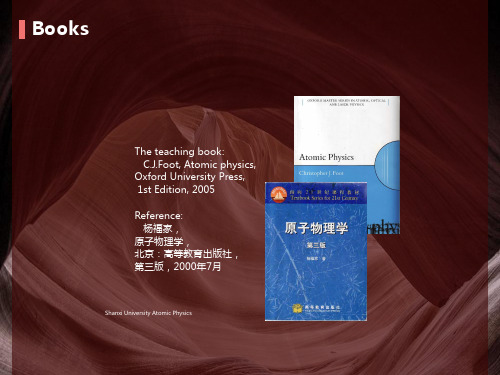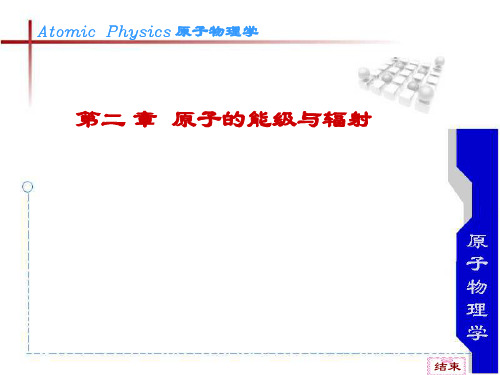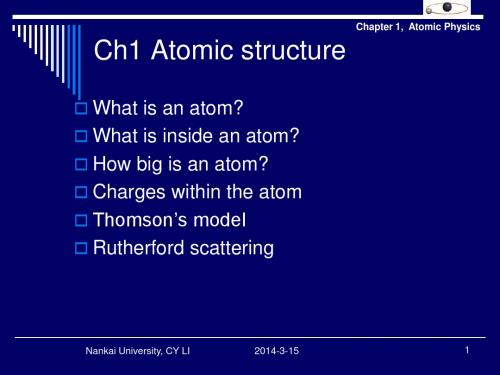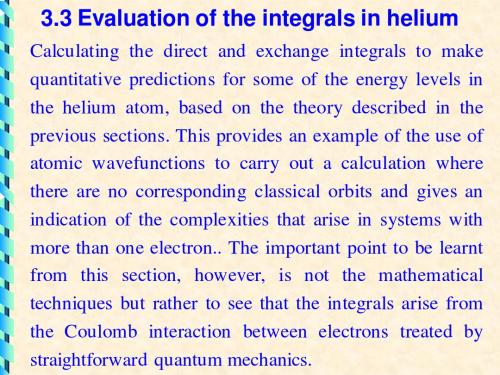英文版原子物理课件
合集下载
核能课件ppt英文

ห้องสมุดไป่ตู้
Advantages and Disadvantages of Nuclear Energy
Advantages
Nuclear energy is a sustainable source of energy that can provide a stable and related supply of electricity It does not emit greenhouse gases or air pollutants during operation, making it environmentally friendly Nuclear energy can also be used to produce medical isotopes and for other industrial applications
History of Nuclear Energy
The discovery of nuclear energy Began in the early 20th century with the discovery of radioactivity by Antoine Henri Becquerel in 1896
Nuclear Power Courseware PowerPoint English
• Introduction • Nuclear Physics • Nuclear Reactors • Safety and Security of Nuclear
Reactors • Future of Nuclear Energy
01 Introduction
Definition of Nuclear Energy
Advantages and Disadvantages of Nuclear Energy
Advantages
Nuclear energy is a sustainable source of energy that can provide a stable and related supply of electricity It does not emit greenhouse gases or air pollutants during operation, making it environmentally friendly Nuclear energy can also be used to produce medical isotopes and for other industrial applications
History of Nuclear Energy
The discovery of nuclear energy Began in the early 20th century with the discovery of radioactivity by Antoine Henri Becquerel in 1896
Nuclear Power Courseware PowerPoint English
• Introduction • Nuclear Physics • Nuclear Reactors • Safety and Security of Nuclear
Reactors • Future of Nuclear Energy
01 Introduction
Definition of Nuclear Energy
(完整版)原子核物理导论(一)PPT文档

7. Nuclear Collisions and Reactions 14. Nuclear and Particle Astrophysics
Nuclear Physics ≠ Nuclear Bomb !!
Aims
•To study the general properties of nuclei •To examine the characteristics of the nuclear force •To introduce the principal models of the nucleus •To discuss the spontaneous decay of nuclei including
those far from the region of stability •To study nuclear reactions, in particular fission and fusion •To introduce detectors •To discuss the practical applications of nuclear physics •To develop problem solving skills in the above areas
原子核物理导论(一) coursename: introduction nuclearphysics原子核物理導論(一)course code 3297instructor:李秉政老師 beginninggod created earthbecame waste broodingupon (genesis1:1 recommendedtextbooks: particlephysics" w.s.c.williams, oxford university press, new york士華圖書公司(02)27033016 "introductorynuclear physics" krane,john wiley sons,inc. "introductorynuclear physics" samuels.m. wong, john wiley sons,inc., new york民權書局有限公司(02)23651662, (02)23657999 "modernatomic nuclearphysics" fujiayang, joseph mcgraw-hillcompanies, inc. contents somequantitative formalities nuclearinstability alphadecay nuclearcollisions nuclearmodels interactions10. hadrons quark-partonmodel 11. electromagneticinteraction 12. weakinteraction 13. particles: summary outlook14. nuclear particleastrophysics nuclear physics nuclearbomb generalproperties nuclearforce principalmodels spontaneousdecay nucleiincluding those far from studynuclear reactions, particularfission introducedetectors practicalapplications nuclearphysics developproblem solving skills abovearea
英文版原子物理课件

Shanxi University Atomic Physics
1.1 Introduction
The origins of atomic physics :quantum mechanics Bohr model of the H This introductory chapter surveys some of the early ideas: Spectrum of atomic H and Bohr Theory Einstein's treatment of interaction of atom with light the Zeeman effect Rutherford scattering And so on
Shanxi University Atomic Physics
1.2 Spectrum of atomic hydrogen_3
Wavenumbers may seem rather old-fashioned but they are very useful in atomic physics
the characteristic spectrum for atoms is composed of discrete lines that are the ‘fingerprint' of the element.
In 1888, the Swedish professor J. Rydberg found that the spectral lines in hydrogen obey the following mathematical formula:
Shanxi University Atomic Physics
Lyman series: n’ = 2; 3; 4; … n = 1. Balmer (n = 2), Paschen series: (n = 3), Brackett (n = 4) and Pfund (n = 5)
1.1 Introduction
The origins of atomic physics :quantum mechanics Bohr model of the H This introductory chapter surveys some of the early ideas: Spectrum of atomic H and Bohr Theory Einstein's treatment of interaction of atom with light the Zeeman effect Rutherford scattering And so on
Shanxi University Atomic Physics
1.2 Spectrum of atomic hydrogen_3
Wavenumbers may seem rather old-fashioned but they are very useful in atomic physics
the characteristic spectrum for atoms is composed of discrete lines that are the ‘fingerprint' of the element.
In 1888, the Swedish professor J. Rydberg found that the spectral lines in hydrogen obey the following mathematical formula:
Shanxi University Atomic Physics
Lyman series: n’ = 2; 3; 4; … n = 1. Balmer (n = 2), Paschen series: (n = 3), Brackett (n = 4) and Pfund (n = 5)
原子物理课件cap6

由于 E 是连续变化的,而 v0 是一定的,
损
连续谱
标示谱
所以 E连续变化.
第 六 章 : X 射 线
即式hv mv0 2 E损 中,v是连续的,作为极限情况,
1 2
E损 0 ,
则
max
(1)
下一页 首页 上一页
从而得到 hvmax 1 mv0 2 = ev 2
第二节:X射线的产生机制
电离电流与射线强度成正比实际上,该试验是将“自然”X光通过 一个用作起偏器的散射体成线偏振的X光,然后 再用另一个散射体作检偏器,检验其偏振性。具 体地说,若X射线是横波,当它沿z方向传播并经 第一个散射体散射后,沿z方向不会有振动;沿x 方向传播的X光再经第二个散射体后,则只有y方 向的振动。因此在xz平面可观察到y方向的线偏 振光。在y方向观察不到X射线。
d3
58 .5
给出,d=0.282nm。 从而在给定θ 下可确定X射线的波长λ 。
测定强度:由谱线的深浅程度可以测出相对强度。
X射线的衍射
P S1 S2 C
A1
O
A
OA/r=2 =OA/2 r 已知晶格常数 d,测出 值及 其对应的n值, 代入布拉格公 式,求出。
oA 2 r
首页 上一页 下一页
第一节:X射线的发现
X射线的性质
1)X射线能使照相底片感光;
2)X射线有很大的贯穿本领;
X射线的 发现
3)X射线能使某些物质的原子、分子电离;
4)X射线是不可见光,它能使某些物质发出 可见光的荧光; 5)X射线本质上是一种电磁波,同此它具有 反射、折射、衍射、偏振等性质。
X射线的 产生
首页 上一页 下一页 X射线的 发现
损
连续谱
标示谱
所以 E连续变化.
第 六 章 : X 射 线
即式hv mv0 2 E损 中,v是连续的,作为极限情况,
1 2
E损 0 ,
则
max
(1)
下一页 首页 上一页
从而得到 hvmax 1 mv0 2 = ev 2
第二节:X射线的产生机制
电离电流与射线强度成正比实际上,该试验是将“自然”X光通过 一个用作起偏器的散射体成线偏振的X光,然后 再用另一个散射体作检偏器,检验其偏振性。具 体地说,若X射线是横波,当它沿z方向传播并经 第一个散射体散射后,沿z方向不会有振动;沿x 方向传播的X光再经第二个散射体后,则只有y方 向的振动。因此在xz平面可观察到y方向的线偏 振光。在y方向观察不到X射线。
d3
58 .5
给出,d=0.282nm。 从而在给定θ 下可确定X射线的波长λ 。
测定强度:由谱线的深浅程度可以测出相对强度。
X射线的衍射
P S1 S2 C
A1
O
A
OA/r=2 =OA/2 r 已知晶格常数 d,测出 值及 其对应的n值, 代入布拉格公 式,求出。
oA 2 r
首页 上一页 下一页
第一节:X射线的发现
X射线的性质
1)X射线能使照相底片感光;
2)X射线有很大的贯穿本领;
X射线的 发现
3)X射线能使某些物质的原子、分子电离;
4)X射线是不可见光,它能使某些物质发出 可见光的荧光; 5)X射线本质上是一种电磁波,同此它具有 反射、折射、衍射、偏振等性质。
X射线的 产生
首页 上一页 下一页 X射线的 发现
原子物理课件cap2

第一节何等的
黑体辐射
困难。然而,历史很快作出了判断,1922年,
爱因斯坦因光电效应获诺贝尔物理奖。
光电效应
光 谱
back
next
目录
结束
(一)光谱 • 光谱是电磁辐射(不论在可见区或在可见区外)的波 长成分和强度分布的记录;有时只是波长成分的记录。 • 光谱是研究原子结构的重要途径之一。 (二)光谱仪 光谱仪:能将混合光按不同波长成分展开成光谱的仪 器。 光谱仪的组成:光源、分光器、记录仪,若装有照相 设备,则称为摄谱仪。
back
next
目录
结束
第二章:原子的量子态:玻尔模型
第一节:背景知识 例如,用光强为 1 / m 2 的光照到钠金属表 面,根据经典理论的推算,至少要 107 秒(约 合120多天)的时间来积聚能量,才会有光电 子产生;事实上,只要ν >ν 0 ,就立即有光电 子产生,可见理论与实验产生了严重的偏离. 此外,按照经典理论,决定电子能量的是光 强,而不是频率.但实验事实却是:
光电效应
光 谱
back
next
目录
结束
第二章:原子的量子态:玻尔模型
第一节:背景知识 早在1887年,德国物理学家赫兹第一个观察 到用紫光照射的尖端放电特别容易发生,这实 际上是光电效应导致的.由于当时还没有电子 的概念,所以对其机制不是很清楚. 直到1897年汤姆逊发现了电子.人们才注意 到一定频率的光照射在金属表面上时,有大量 电子从表面逸出,人们称之为光电效应。光 电效应呈现出以下特点: 1.对一定金属有一个临界频率v0 ,当ν <ν 时,无论光强多大,无电子产生;
黑体辐射实验
前者导致了相对论的诞生后,后者导致了量 子论的诞生。
黑体辐射
困难。然而,历史很快作出了判断,1922年,
爱因斯坦因光电效应获诺贝尔物理奖。
光电效应
光 谱
back
next
目录
结束
(一)光谱 • 光谱是电磁辐射(不论在可见区或在可见区外)的波 长成分和强度分布的记录;有时只是波长成分的记录。 • 光谱是研究原子结构的重要途径之一。 (二)光谱仪 光谱仪:能将混合光按不同波长成分展开成光谱的仪 器。 光谱仪的组成:光源、分光器、记录仪,若装有照相 设备,则称为摄谱仪。
back
next
目录
结束
第二章:原子的量子态:玻尔模型
第一节:背景知识 例如,用光强为 1 / m 2 的光照到钠金属表 面,根据经典理论的推算,至少要 107 秒(约 合120多天)的时间来积聚能量,才会有光电 子产生;事实上,只要ν >ν 0 ,就立即有光电 子产生,可见理论与实验产生了严重的偏离. 此外,按照经典理论,决定电子能量的是光 强,而不是频率.但实验事实却是:
光电效应
光 谱
back
next
目录
结束
第二章:原子的量子态:玻尔模型
第一节:背景知识 早在1887年,德国物理学家赫兹第一个观察 到用紫光照射的尖端放电特别容易发生,这实 际上是光电效应导致的.由于当时还没有电子 的概念,所以对其机制不是很清楚. 直到1897年汤姆逊发现了电子.人们才注意 到一定频率的光照射在金属表面上时,有大量 电子从表面逸出,人们称之为光电效应。光 电效应呈现出以下特点: 1.对一定金属有一个临界频率v0 ,当ν <ν 时,无论光强多大,无电子产生;
黑体辐射实验
前者导致了相对论的诞生后,后者导致了量 子论的诞生。
原子物理第1章.ppt

Thomson模型
原子球体内,电子镶嵌在其 中。原子如同西瓜,瓜瓤好
α散射实验
比正电荷,电子如同瓜籽分 布在其中。
Thomson模 型的失败
同时该模型还进一步假定,电子分布在分 Rutherford模 离的同心环上,每个环上的电子容量都不相同, 型的提出
电子在各自的平衡位置附近做微振动。因而可
以发出不同频率的光,而且各层电子绕球心转
米,原子之间是紧密地堆积在一起的。若该
元素的原子量为A,那么1mol该原子的质量
为A,若这种原子的质量密度为 (g/cm3), 那么A克原子的总体积为 A/(cm3) ,一个
原所子以占原的子有的体半积径为r34 33r A 3,/4即N 34A,r依3*此NA可以A/算
出不同原子的半径,如下表所示:
α散射实验
Thomson模 型的失败 Rutherford模 型的提出
back
next 目录 结束
第一章:原子的基本状况:卢斯福模型
第二节:原子结构模型
卢瑟福1871年8月30日生于新西 兰的纳尔逊,毕业于新西兰大学 和剑桥大学。
1898年到加拿大任马克歧尔大 学物理学教授,达9年之久,这期 间他在放射性方面的研究,贡献 极多。 1907年,任曼彻斯特大学 物理学教授。1908年因对放射化 学的研究荣获诺贝尔化学奖。 1919年任剑桥大学教授,并任卡 文迪许实验室主任。1931年英王 授予他勋爵的桂冠。1937年10月 19日逝世。
Atomic Physics 原子物理学
第一章:原子的基本状况:卢斯福模型
第一节 从哲学到科学的原子论
第二节 原子结构的卢斯福模型
第三节 卢斯福散射公式
第四节 卢斯福公式的实验验证 第五节 原子核大小的推断 第六节 行星模型的意义与困难
最新2019-原子物理第2章-PPT课件

连续谱:固体的高温辐射。
黑体辐射 光电效应 光谱
back
next 目录 结束
第二章:原子的能级与辐射:玻尔理论
第一节:原子光谱
带光谱:波长在各区域内连续变化,此为分 子光谱;
黑体辐射 光电效应 光谱
back
next 目录 结束
第二章:原子的能级与辐射:玻尔理论
第一节:原子光谱
线光谱:波长不连续变化,此种为原子光谱; 黑体辐射
RHeZ2RH
~Z2RH(n112
1 n22
)
~HeRH(n1122n2122)
上式中n1取4,n2取5、6、7、….就与毕克林系规律相同
back
next 目录 结束
第二章:原子的能级与辐射:玻尔理论
第四节:类氢离子光谱
尽管上述结果与观察结果非常一致,但还有一个明显 的差别:类氢离子光谱与氢光谱并不完全重合。
22me4 RH (4 0)2h3c
back
next
玻尔假设 电子的运 动 氢光谱的 解释
目录 结束
第二章:原子的能级与辐射:玻尔理论
第三节:玻尔模型
从理论上导出里德伯常数:
RH
22me4 (4 0)2h3c
h 6.626201034 J .s e 1.602191019 C m 9.109561031 k g
back
next 目录 结束
第二章:原子的能级与辐射:玻尔理论
第一节:原子光谱
光谱的分类:不同的光源有不同的光谱,发出 机制也不尽相同,根据波长的变化情况,大致 可分为三类:
连续谱、带光谱、线光谱
黑体辐射 光电效应 光谱
back
next 目录 结束
第二章:原子的能级与辐射:玻尔理论
原子物理课件 杨福家

Nankai University, CY LI 2014-3-15 2
Chapter 1, Atomic Physics
Relative atomic masses
A relative mass called atomic mass unit (u) is used
to mark the mass of atoms. The unit of atomic mass is based on the carbon atom, that is, the mass of carbon-12 is equal to 12.00000u. Or: 1u=1/12 of the mass of a neutral carbon atom with nuclear charge 6 and mass number 12. 1u is approximately equal to the mass of a hydrogen atom. M(H)=1.0079u
Chapter 1, Atomic Physics
Ch1 Atomic structure
What is an atom?
What is inside an atom? How big is an atom? Charges within the atom Thomson’s model Rutherford scattering
material radium, pass through a collimator (瞄准仪) and strike a thin metal foil. Passed particles will make the zinc sulfide screen flash when striking it. The entire apparatus is placed in a vacuum chamber.
Chapter 1, Atomic Physics
Relative atomic masses
A relative mass called atomic mass unit (u) is used
to mark the mass of atoms. The unit of atomic mass is based on the carbon atom, that is, the mass of carbon-12 is equal to 12.00000u. Or: 1u=1/12 of the mass of a neutral carbon atom with nuclear charge 6 and mass number 12. 1u is approximately equal to the mass of a hydrogen atom. M(H)=1.0079u
Chapter 1, Atomic Physics
Ch1 Atomic structure
What is an atom?
What is inside an atom? How big is an atom? Charges within the atom Thomson’s model Rutherford scattering
material radium, pass through a collimator (瞄准仪) and strike a thin metal foil. Passed particles will make the zinc sulfide screen flash when striking it. The entire apparatus is placed in a vacuum chamber.
原子物理(00003)市公开课金奖市赛课一等奖课件

第三章:量子力学初步
第四节:薛定谔方程
定态薛定谔方程
由
1 u
2 2m
2u
Vu
i f
f t
E
得
i f E f t
f
(t )
Fe
iE
t
定态 力学量算符
2 2u Vu Eu 2m
定态薛定谔方程
xyzt
u
xyz
e
iE
t
back
next
目录 结第束23页
第三章:量子力学初步
第四节:薛定谔方程
d d
称为几率密度
波函数意义
波函数特性
波函数与玻尔轨 道量子化条件
back
next
目录 结第束16页
第三章:量子力学初步
第三节:波函数及其物理意义
按照波函数物理意义,波函数应当满足条件: 连续、单值、有限、归一化
d 1
波函数意义
波函数特性
波函数与玻尔轨 道量子化条件
back
next
目录 结第束17页
第三章:量子力学初步
第五节:量子力学问题简例
一维无限深势井中粒子
V x
uI
(x)
C
cos
n
a
D
sin
n
a
x x
uII (x) 0
n 1,3,5,
II n 0,2,4,6,
I V 0
a 2
II 无限势井 简谐振子
势垒
ax
2
使用归一化条件:
u2 xdx 1
a 2 C 2 cos2 n xdx 1
自由粒子波函数:
k
0cos
t
rk V
L7_Chap3英文版原子物理课件

sin q1d q1d f 1 sin q2 d q2 d f 2
Shanxi University Atomic Physics
3.3.2 Excited states: the direct integral_4
The calculation of this integral requires the expansion of 1 r12 in terms of spherical harmonics:
r2
V12 (r2 ) =
Shanxi University Atomic Physics
ò0Biblioteka 1 r (r1 )d 3r 1 4p r12
(3.21)
3.3.1 Ground State_2
The spherical symmetry of s-electrons means that the charge in the region origin, so that
3.3.2 Excited states: the direct integral_2
In the expression for H 0a ,electron 2 experiences the Coulomb attraction of a charge +1e. In
e 2 4pe0 r2
' Ha
J 1s 2 e = 2 6 a0 4pe0
2 r2
{ 蝌
0 0
1 4 Z 3e- ( Z a0 )2 r1 r12 dr1}4 Z 3e- ( Z a0 )2 r2 r2 2 dr2 r2
e2 4pe0 5 5 = Z = (13.6eV ) Z 2a0 4 4
(3.24)
Shanxi University Atomic Physics
3.3.2 Excited states: the direct integral_4
The calculation of this integral requires the expansion of 1 r12 in terms of spherical harmonics:
r2
V12 (r2 ) =
Shanxi University Atomic Physics
ò0Biblioteka 1 r (r1 )d 3r 1 4p r12
(3.21)
3.3.1 Ground State_2
The spherical symmetry of s-electrons means that the charge in the region origin, so that
3.3.2 Excited states: the direct integral_2
In the expression for H 0a ,electron 2 experiences the Coulomb attraction of a charge +1e. In
e 2 4pe0 r2
' Ha
J 1s 2 e = 2 6 a0 4pe0
2 r2
{ 蝌
0 0
1 4 Z 3e- ( Z a0 )2 r1 r12 dr1}4 Z 3e- ( Z a0 )2 r2 r2 2 dr2 r2
e2 4pe0 5 5 = Z = (13.6eV ) Z 2a0 4 4
(3.24)
- 1、下载文档前请自行甄别文档内容的完整性,平台不提供额外的编辑、内容补充、找答案等附加服务。
- 2、"仅部分预览"的文档,不可在线预览部分如存在完整性等问题,可反馈申请退款(可完整预览的文档不适用该条件!)。
- 3、如文档侵犯您的权益,请联系客服反馈,我们会尽快为您处理(人工客服工作时间:9:00-18:30)。
Shanxi University Atomic Physics
Chapter 1 Early atomic physics
1.1 Introduction 1.2 Spectrum of atomic hydrogen 1.3 Bohr's theory 1.4 Relativistic effects 1.5 Moseley and the atomic number 1.6 Radiative decay 1.7 Einstein A and B coeffecients 1.8 The Zeeman effect
Shanxi University Atomic Physics
Lyman series: n’ = 2; 3; 4; … n = 1. Balmer (n = 2), Paschen series: (n = 3), Brackett (n = 4) and Shanxi University Atomic Physics
Books
The teaching book: C.J.Foot, Atomic physics, Oxford University Press, 1st Edition, 2005
Reference: 杨福家, 原子物理学, 北京:高等教育出版社, 第三版,2000年7月
Shanxi University Atomic Physics
Shanxi University Atomic Physics
1.1 Introduction
Before describing the theory of an atom with one electron, some experimental facts are presented. This
e2 / 4 0 2 me r 3
(1.4)
This is equivalent to Kepler's laws for planetary orbits relating the square of the period 2=! to the cube of the radius (as expected since all steps have been purely classical mechanics). The total energy of an electron in such an orbit is the sum of its kinetic and potential energiriment followed by explanation reflects
the author's opinion that atomic physics should not be presented as applied quantum mechanics, but it should be motivated by the desire to understand experiments. This represents what really happens in research where
Examination of the sums and differences of the wavenumbers of transitions gives clues that enable the underlying structure to be deduced, rather like a crossword Puzzle--some examples of this are given in later chapters.
E
Shanxi University Atomic Physics
e / 4 0 1 me v 2 2 r
(1.5)
1.3 Bohr’s theory-3
Using eqn 1.3 we nd that the kinetic energy has a magnitude equal to half the potential energy (an example of the virial theorem). Taking into account the opposite signs of kinetic and potential energy, we find
Pfund (n = 5)
1.3 Bohr’s theory-2
Bohr assumed that each electron orbits the nucleus in a circle, whose radius r is determined by the balance between centripetal acceleration and the Coulomb attraction towards the proton. For electrons of mass me and speed v this gives
e / 4 0 E 2r
2
(1.6)
This total energy is negative because the electron is bound to the proton and energy must be supplied to remove it. To go further Bohr made the following assumption. Assumption I: There are certain allowed orbits for which the electron has a xed energy. The electron loses energy only when it jumps between the allowed orbits and the atom emits this energy as light of a given wavelength.
In practice, the units used for a given quantity are related to the method used to measure it, e.g. spectroscopes and spectrographs are calibrated in terms of wavelength.
The observed spectral lines in hydrogen can all be expressed as differences between energy levels. Which as shown in Fig. 1.1, where the energies are proportional to 1/n2. The following section looks at how these spectra can be explained theoretically.
Shanxi University Atomic Physics
1.2 Spectrum of atomic hydrogen_3
1
Wavenumber
Wavenumbers may seem rather old-fashioned but they are very useful in atomic physics
Ritz combination principle: the wavenumbers of certain lines in the spectrum can be expressed as sums .
Shanxi University Atomic Physics
1.2 Spectrum of atomic hydrogen_4
most advances come about through the interplay of
theory and experiment.
Shanxi University Atomic Physics
1.2 Spectrum of atomic hydrogen_2
the characteristic spectrum for atoms is composed of discrete lines that are the ‘fingerprint' of the element. In 1888, the Swedish professor J. Rydberg found that the spectral lines in hydrogen obey the following mathematical formula: 1 1 1 R( 2 2 ) n n' n and n’ : whole numbers; R : Rydberg constant. Balmer series: spectral lines for which n = 2 and n’ = 3; 4; … The first line at 656 nm is called the Balmer- (or H) line
me v 2 e2 r 4 0 r 2
(1.3)
In SI units the strength of the electrostatic interaction between two charges of magnitude e is characterised by the combination of constants e2/40. This leads to the following relation between the angular frequency = v/r and the radius:
1.8.1 Experimental observation of the Zeeman effect
1.9 Summary of atomic units Exercises
Chapter 1 Early atomic physics
1.1 Introduction 1.2 Spectrum of atomic hydrogen 1.3 Bohr's theory 1.4 Relativistic effects 1.5 Moseley and the atomic number 1.6 Radiative decay 1.7 Einstein A and B coeffecients 1.8 The Zeeman effect
Shanxi University Atomic Physics
Lyman series: n’ = 2; 3; 4; … n = 1. Balmer (n = 2), Paschen series: (n = 3), Brackett (n = 4) and Shanxi University Atomic Physics
Books
The teaching book: C.J.Foot, Atomic physics, Oxford University Press, 1st Edition, 2005
Reference: 杨福家, 原子物理学, 北京:高等教育出版社, 第三版,2000年7月
Shanxi University Atomic Physics
Shanxi University Atomic Physics
1.1 Introduction
Before describing the theory of an atom with one electron, some experimental facts are presented. This
e2 / 4 0 2 me r 3
(1.4)
This is equivalent to Kepler's laws for planetary orbits relating the square of the period 2=! to the cube of the radius (as expected since all steps have been purely classical mechanics). The total energy of an electron in such an orbit is the sum of its kinetic and potential energiriment followed by explanation reflects
the author's opinion that atomic physics should not be presented as applied quantum mechanics, but it should be motivated by the desire to understand experiments. This represents what really happens in research where
Examination of the sums and differences of the wavenumbers of transitions gives clues that enable the underlying structure to be deduced, rather like a crossword Puzzle--some examples of this are given in later chapters.
E
Shanxi University Atomic Physics
e / 4 0 1 me v 2 2 r
(1.5)
1.3 Bohr’s theory-3
Using eqn 1.3 we nd that the kinetic energy has a magnitude equal to half the potential energy (an example of the virial theorem). Taking into account the opposite signs of kinetic and potential energy, we find
Pfund (n = 5)
1.3 Bohr’s theory-2
Bohr assumed that each electron orbits the nucleus in a circle, whose radius r is determined by the balance between centripetal acceleration and the Coulomb attraction towards the proton. For electrons of mass me and speed v this gives
e / 4 0 E 2r
2
(1.6)
This total energy is negative because the electron is bound to the proton and energy must be supplied to remove it. To go further Bohr made the following assumption. Assumption I: There are certain allowed orbits for which the electron has a xed energy. The electron loses energy only when it jumps between the allowed orbits and the atom emits this energy as light of a given wavelength.
In practice, the units used for a given quantity are related to the method used to measure it, e.g. spectroscopes and spectrographs are calibrated in terms of wavelength.
The observed spectral lines in hydrogen can all be expressed as differences between energy levels. Which as shown in Fig. 1.1, where the energies are proportional to 1/n2. The following section looks at how these spectra can be explained theoretically.
Shanxi University Atomic Physics
1.2 Spectrum of atomic hydrogen_3
1
Wavenumber
Wavenumbers may seem rather old-fashioned but they are very useful in atomic physics
Ritz combination principle: the wavenumbers of certain lines in the spectrum can be expressed as sums .
Shanxi University Atomic Physics
1.2 Spectrum of atomic hydrogen_4
most advances come about through the interplay of
theory and experiment.
Shanxi University Atomic Physics
1.2 Spectrum of atomic hydrogen_2
the characteristic spectrum for atoms is composed of discrete lines that are the ‘fingerprint' of the element. In 1888, the Swedish professor J. Rydberg found that the spectral lines in hydrogen obey the following mathematical formula: 1 1 1 R( 2 2 ) n n' n and n’ : whole numbers; R : Rydberg constant. Balmer series: spectral lines for which n = 2 and n’ = 3; 4; … The first line at 656 nm is called the Balmer- (or H) line
me v 2 e2 r 4 0 r 2
(1.3)
In SI units the strength of the electrostatic interaction between two charges of magnitude e is characterised by the combination of constants e2/40. This leads to the following relation between the angular frequency = v/r and the radius:
1.8.1 Experimental observation of the Zeeman effect
1.9 Summary of atomic units Exercises
